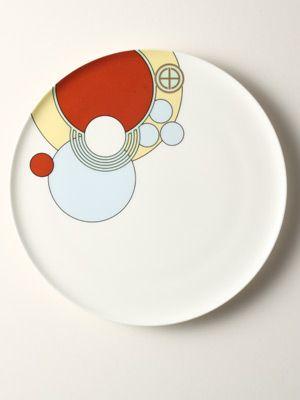To attract western travelers to Japan, the government of Japan commissioned American architect Frank Lloyd Wright (1867-1959) to design the Imperial Hotel in Tokyo. Wright's all-encompassing designs for his buildings included almost every item, including dinnerware.
Known as the Cabaret pattern, this porcelain dinnerware was designed for the Cabaret Dining Room of the Imperial Hotel, which opened in 1923. The circular art-deco-inspired design was Wright's interpretation of champagne bubbles overflowing across the place settings. The strategically placed red on the cup's rim has been suggested to conceal lipstick prints from women drinking from the coffee cups.
The dinnerware was originally produced by Japan's Noritake company with reproductions made by Tiffany. The Imperial Hotel was demolished in 1968, but its entrance and lobby have been preserved and can be visited at Japan's Meiji-mura, an open-air architectural museum and park.
Question: How can I find out how much my Remington sculpture is worth? It's dated 1876.
Answer: Frederic Remington (1861-1909) was a painter before turning to sculpture in the 1890s. He made 22 sculptures, which were cast at either the Roman Bronze Works or Henry-Bonnard Bronze Co. If your sculpture doesn't have one of those foundry marks, it's a reproduction. The number 1876 isn't the date.
If your sculpture is an original Remington, the number indicates its place in the production sequence. Reproductions were sometimes numbered the way limited editions are marked. Original Remingtons sell for thousands of dollars. Some reproductions sell for several hundred dollars. If you take it to a museum, they should be able to tell you if it's an original Remington or a good reproduction. An antiques shop that sells bronzes can estimate the value.
A: Your mini horse was made by Wagner Handwork Company in Rodental, West Germany. It probably originally had a red saddle as well as reins. West Germany (Federal Republic of Germany) existed from 1949 until Germany was reunited in 1990.
The German word "Kunstlerschutz" means "artist protected," similar to a copyright. Fritz Wagner started the company in the late 1940s. He created over 300 different animals ranging from about 2 inches to about 7 ¾ inches. The company was run by members of the Wagner family until it closed in 1998. The label you describe was used from 1966 to 1983. The name "Wagner" instead of "Kunstlerschutz" was used on labels from 1983 to 1990. After 1990, the labels said "Germany" instead of "West Germany."
Q: I have a large collection of old 33 LPs. Most are more than 40 years old, and some are 50 years or more. Are they valuable?
A: Vinyl records were popular from the 1950s to the 1980s, dropping in popularity in the '90s, when new formats took over. Listeners have discovered the sound quality is better and fuller on vinyl records than on digital versions, so vinyl records have become more popular again. Sales have increased in the past 15 years and now outpace the sale of music on other physical formats.
The value of your old records depends on the popularity of the artist, rarity and condition. You can get an idea of their value by taking them to a local store that sells old records. There are also online sites that give record values. Goldmine Magazine has a record store directory and other information on its website, www.goldminemag.com.

TIP: Don't clean coins. Collectors want coins with the patina unchanged.
Terry Kovel and Kim Kovel answer readers' questions sent to the column. Send a letter with one question describing the size, material (glass, pottery) and what you know about the item. Include only two pictures, the object and a closeup of any marks or damage.Write to Kovels, (Name of this newspaper), King Features Syndicate, 628 Virginia Dr., Orlando, FL 32803 or email us at collectorsgallery@kovels.com.
CURRENT PRICES
Current prices are recorded from antiques shows, flea markets, sales and auctions throughout the United States. Prices vary in different locations because of local economic conditions.
Belleek dinner bell, yellow loop handle, lobed body, ivory color glaze, raised yellow clusters, scalloped rim, metal ringer, gold backstamp, 7th mark, Ireland, 5 inches, $19.
Bohemian glass vase, green, enamel clover leaves and blossoms, gold trim, flared lip, round foot, signed "St. Vaast La-Hogue" in script, marked "Importe," 6 ½ inches, $72.
Bathtub, salesman's sample, cast iron, light green enamel, four-footed, embossed "Doulton" on side, Royal Doulton, 20th century, 6 ¼ inches long, $163.
Textile, needlework, embroidered, silk, Irish crest, Erin Go Bragh, blue ground, openwork border, frame, 29 ½ x 27 ½ inches, $192.
Decoy, swan, wooden head and neck, carved, canvas over wire body, wood base, painted, white, black beak, early 20th century, $250.
Barometer, yellow wood case, glazed, round dial, French text, thermometer in cartouche above, urn and garland finial, leafy base, P.F. Bollenbach, Barrington, Illinois, c. 1920, 40 x 15 inches, $310.
Game box, opens to checkerboard, backgammon interior, papier-mache, black lacquer, mother-of-pearl inlay, gilt highlights, storage compartment, ivory game pieces, red and white, four dice cups, Victorian, England, c. 1860, 3 ¼ x 16 ¼ x 8 ¾ inches, $563.
Jewelry, pendant, green and orange enamel, three shamrocks, suspended from round green cabochon, green trefoil drop, silver chain, Arts & Crafts, c. 1905, 22-inch chain, 2 ¾ x 1 ½ inch pendant, $625.
Advertising clock, "Chrysler MoPar Parts Accessories," round, yellow center with red border, Arabic numerals, printed, milk glass, domed glass cover, chrome surround, pressed paper back, electric, 14 ¾ inches, $756.
Lamp, newel post, five-light, figural, draped woman, holding flowering branch above head, light fixtures as flowers, green and white beaded shades, round base, spelter, foundry seal, France, early 20th century, 49 inches, $2,375.
